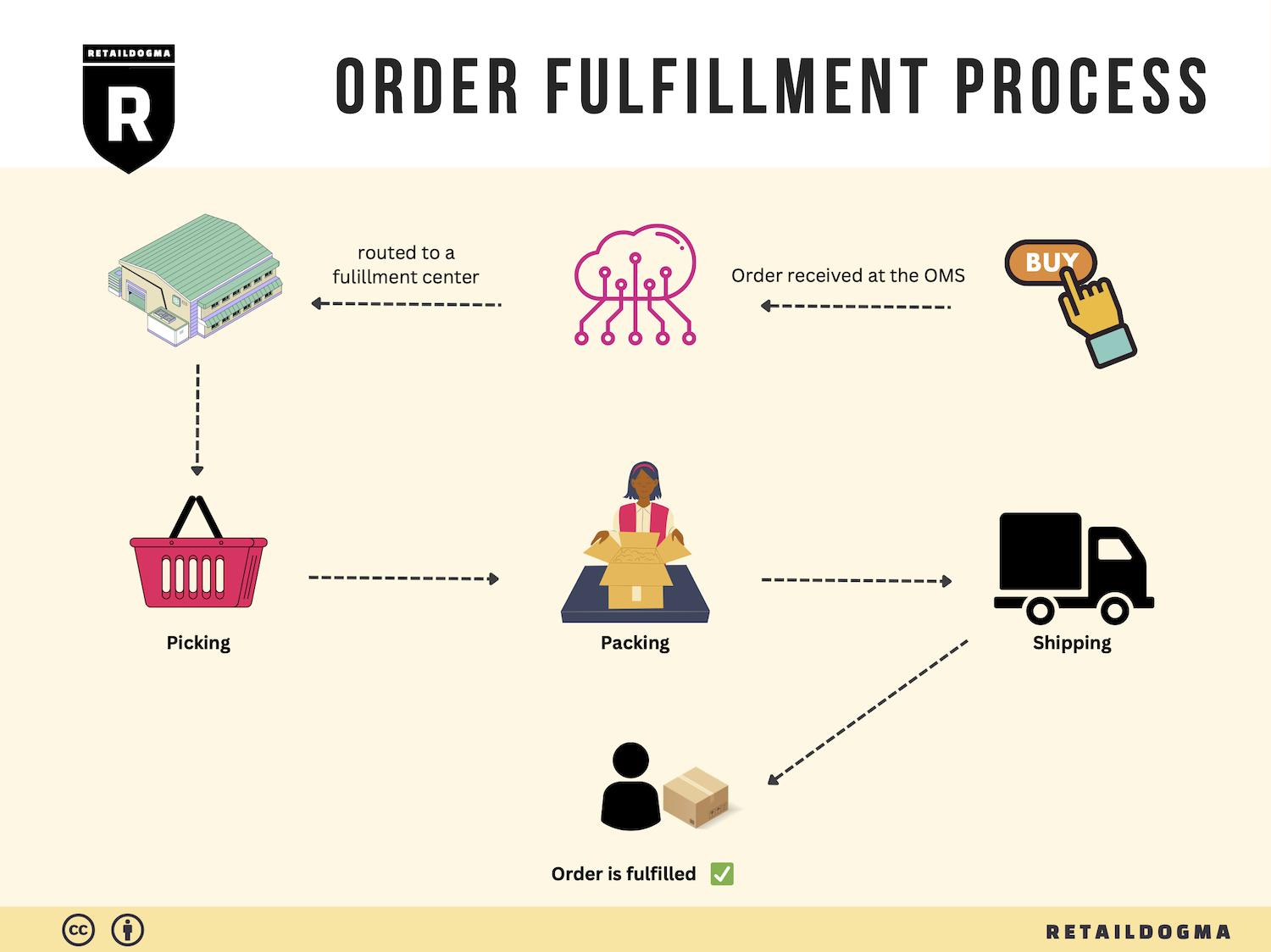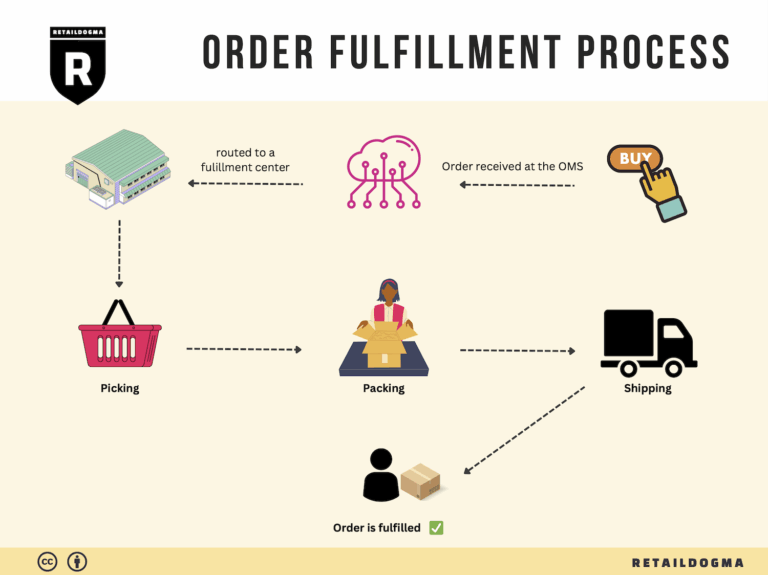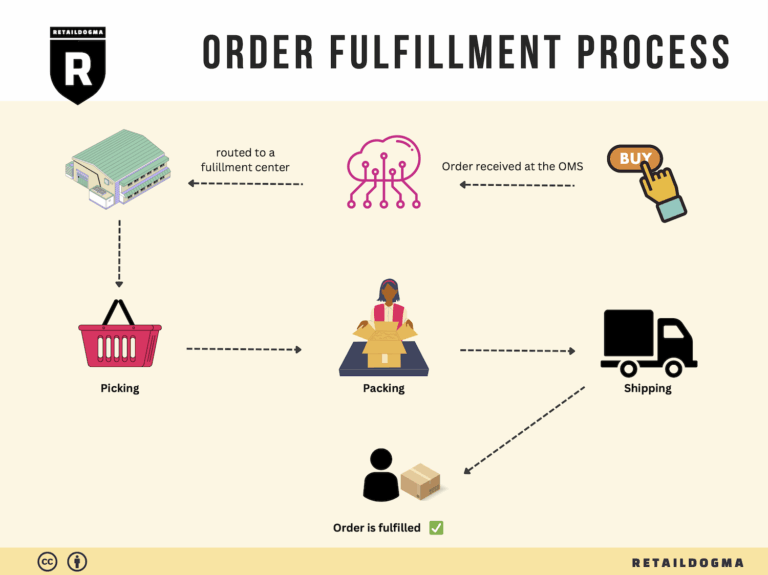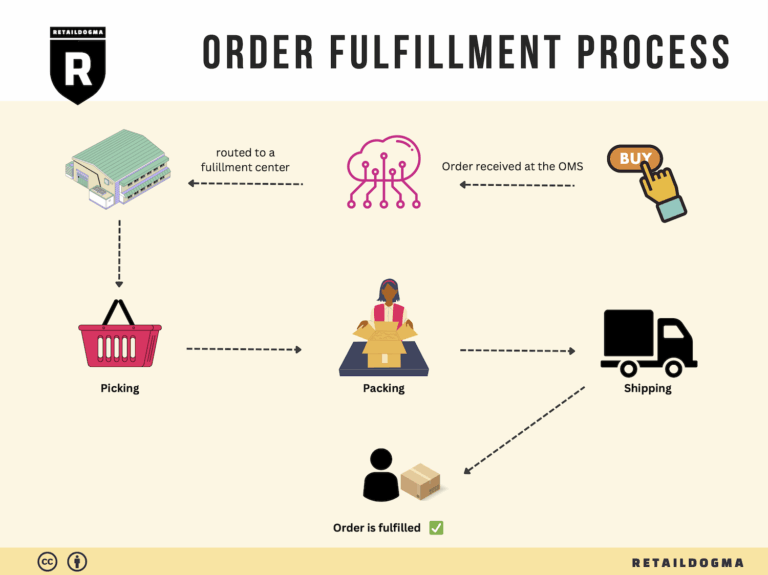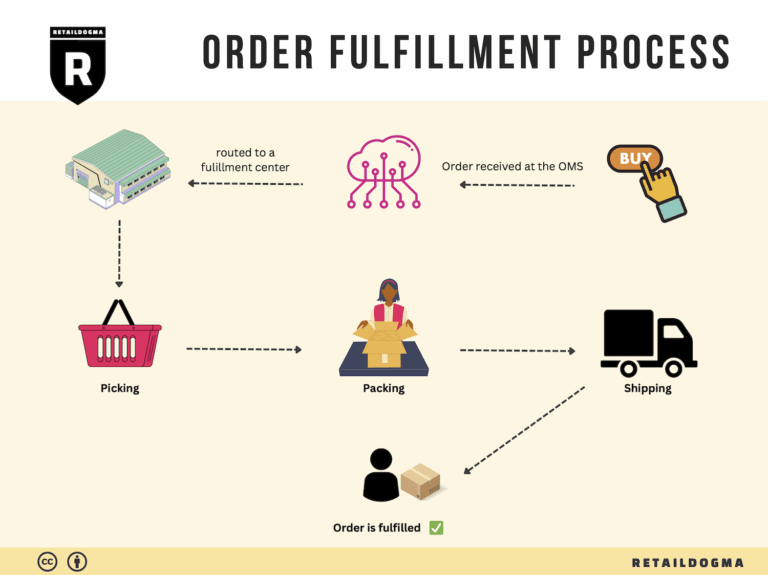What Is A Fulfillment Center? A Complete Guide (2025)
What is E-commerce Fulfillment? An Introduction for Growing Businesses
Understanding E-commerce Fulfillment
As your online business grows, the initial excitement of increased sales can quickly turn into a daunting challenge. One of the most common pain points for entrepreneurs is managing the overwhelming task of packing and shipping orders. The intricate logistics of getting a product from your warehouse to your customer’s doorstep can become a substantial drain on your time and resources. This is where understanding e-commerce fulfillment becomes essential.
At its core, fulfillment is the process of delivering products to customers. It encompasses everything from inventory management to order processing, packing, shipping, and handling returns. Efficient fulfillment is critical not only for customer satisfaction but also for your business’s scalability. As you scale, the question becomes: how can you streamline this process without sacrificing quality?
This guide aims to demystify the various facets of e-commerce fulfillment. We will explore different fulfillment models, such as third-party logistics (3PL) and Fulfillment by Amazon (FBA), which can significantly reduce the burden on your operations. Each model has its pros and cons, and understanding these will help you determine the best fit for your business.
In addition to fulfillment models, we will outline core services that are crucial to an effective fulfillment strategy. These include inventory management, order processing, and shipping solutions. Knowing what services to look for can save you time and enhance your operational efficiency.
Choosing the right fulfillment partner is another critical step in this journey. We will provide insights into the key factors to consider when evaluating potential partners, such as their technology, scalability, and customer service capabilities. A well-chosen partner can elevate your business and allow you to focus on growth rather than logistics.
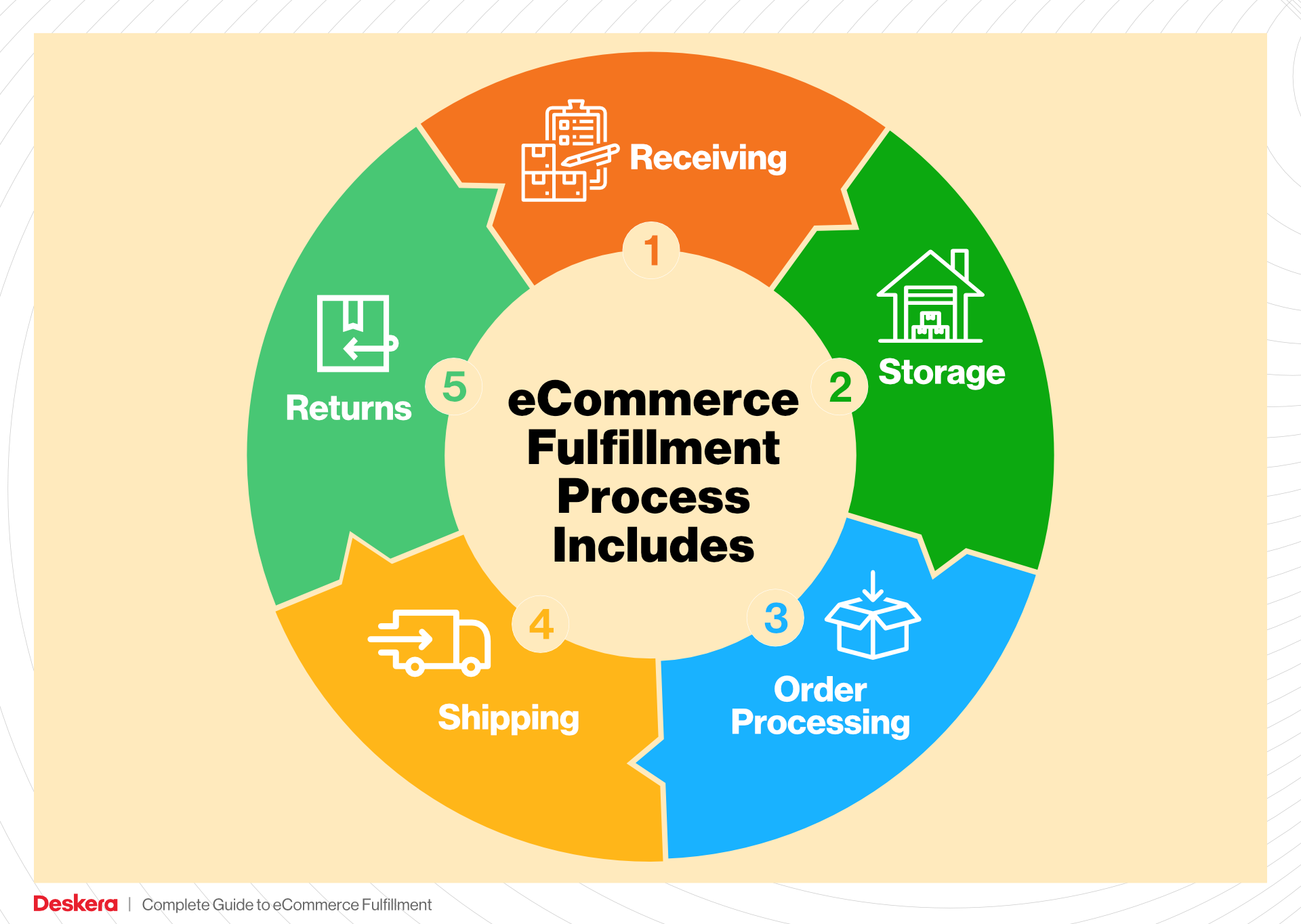
Finally, we will discuss pricing structures associated with various fulfillment options. Understanding the costs involved will empower you to make informed decisions that align with your budget and growth objectives.
The goal of this guide is to equip you with the knowledge and tools to make smart decisions regarding your logistics. By understanding the intricacies of e-commerce fulfillment, you can enhance customer satisfaction, streamline operations, and ultimately drive your business towards sustained growth. Whether you’re just starting or looking to scale, mastering fulfillment is a vital step in your e-commerce success story.
What You’ll Learn In This Guide
- What is E-commerce Fulfillment? An Introduction for Growing Businesses
- The Order Fulfillment Process: From ‘Buy’ Button to Customer’s Door
- Comparing Fulfillment Models: In-House vs. 3PL vs. Dropshipping
- A Deep Dive into Amazon FBA: Pros, Cons, and Who It’s For
- Core Services Offered by Fulfillment Centers
- How to Choose a Fulfillment Partner: A 6-Point Checklist
- Understanding Fulfillment Pricing: A Breakdown of Common Fees
- Frequently Asked Questions (FAQs) about Fulfillment
- Conclusion: Is Outsourcing Fulfillment the Right Move for Your Business?
- Important Disclaimer
The Order Fulfillment Process: From ‘Buy’ Button to Customer’s Door
1. Receiving Inventory
The order fulfillment process begins with receiving inventory, where suppliers deliver products to your warehouse or fulfillment center. This step is crucial as it sets the stage for efficient operations. During this phase, you inspect the incoming goods for quality and quantity against purchase orders.
Key tasks include verifying that the products match the expected shipment details and checking for any damages. This step is critical to maintain accurate inventory levels, which helps avoid stockouts and overstock situations. Implementing a systematic approach, such as using SKU (Stock Keeping Unit) codes, can streamline this process by allowing for quick identification and tracking of each product.
An organized receiving process minimizes discrepancies and ensures that the inventory is ready for the next steps in the fulfillment chain. Regular audits during this phase can enhance accuracy and help maintain supplier relationships by addressing issues promptly.
2. Warehouse Storage
Once the inventory has been received and verified, the next step is warehouse storage. Proper organization within your storage facility is vital for operational efficiency. Products should be stored in a manner that maximizes space and facilitates easy access.
This involves categorizing items based on their demand, size, and type. For example, high-demand items may be placed closer to the packing area to expedite the order fulfillment process. Using a warehouse management system (WMS) can automate storage assignments and track inventory levels in real time.
Effective storage solutions not only enhance picking efficiency but also reduce the time employees spend searching for products. A well-organized warehouse leads to faster order processing, which is critical in meeting customer expectations for timely deliveries.
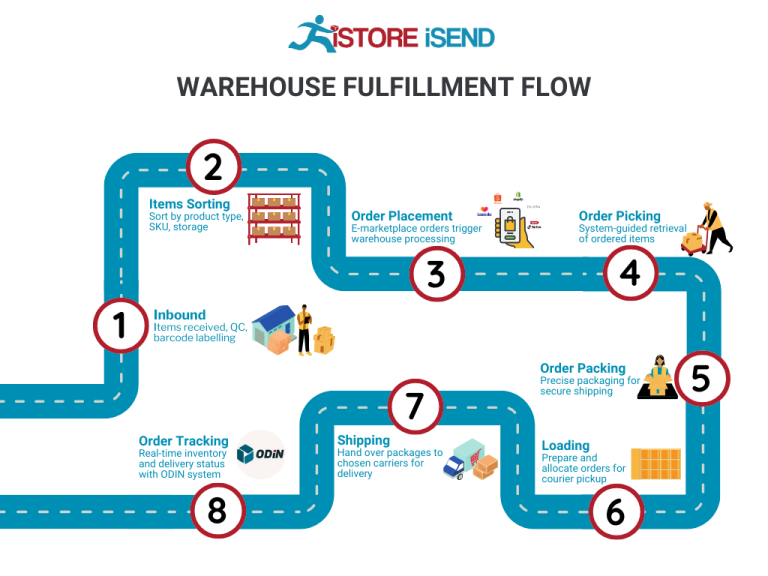
3. Order Picking
Order picking is the process where items are selected from storage to fulfill customer orders. This step is one of the most labor-intensive phases in the fulfillment process, making its efficiency paramount.
Orders are typically compiled into pick lists, which detail the items and their locations within the warehouse. There are various picking methods, such as single order picking or batch picking, depending on the volume of orders and warehouse layout.
The accuracy of this step directly impacts customer satisfaction; errors in picking can lead to wrong items being shipped, resulting in returns and customer dissatisfaction. Implementing technologies such as barcode scanners or RFID (Radio Frequency Identification) systems can enhance accuracy and speed during this process, ensuring that the correct items are selected and reducing the chances of human error.
4. Order Packing
After the items have been picked, they move on to the order packing stage. This step involves securely packaging products to protect them during transit. It is essential for reducing damages and ensuring that items arrive in perfect condition.
Effective packing requires choosing the right materials, such as boxes, cushioning, and tape. Additionally, including packing slips and return instructions can enhance the customer experience. The use of packaging software can also help streamline this process by automatically calculating the most efficient packaging options based on the dimensions and weight of the items.
Proper packing not only safeguards the products but also reflects your brand’s commitment to quality. A well-packed order can enhance customer satisfaction and encourage repeat business, making this step a critical component of the fulfillment process.
5. Shipping & Delivery
The final step in the order fulfillment process is shipping and delivery. This phase entails selecting the appropriate shipping method and carrier to ensure timely delivery to the customer. Factors to consider include shipping costs, delivery speed, and reliability of the carrier.
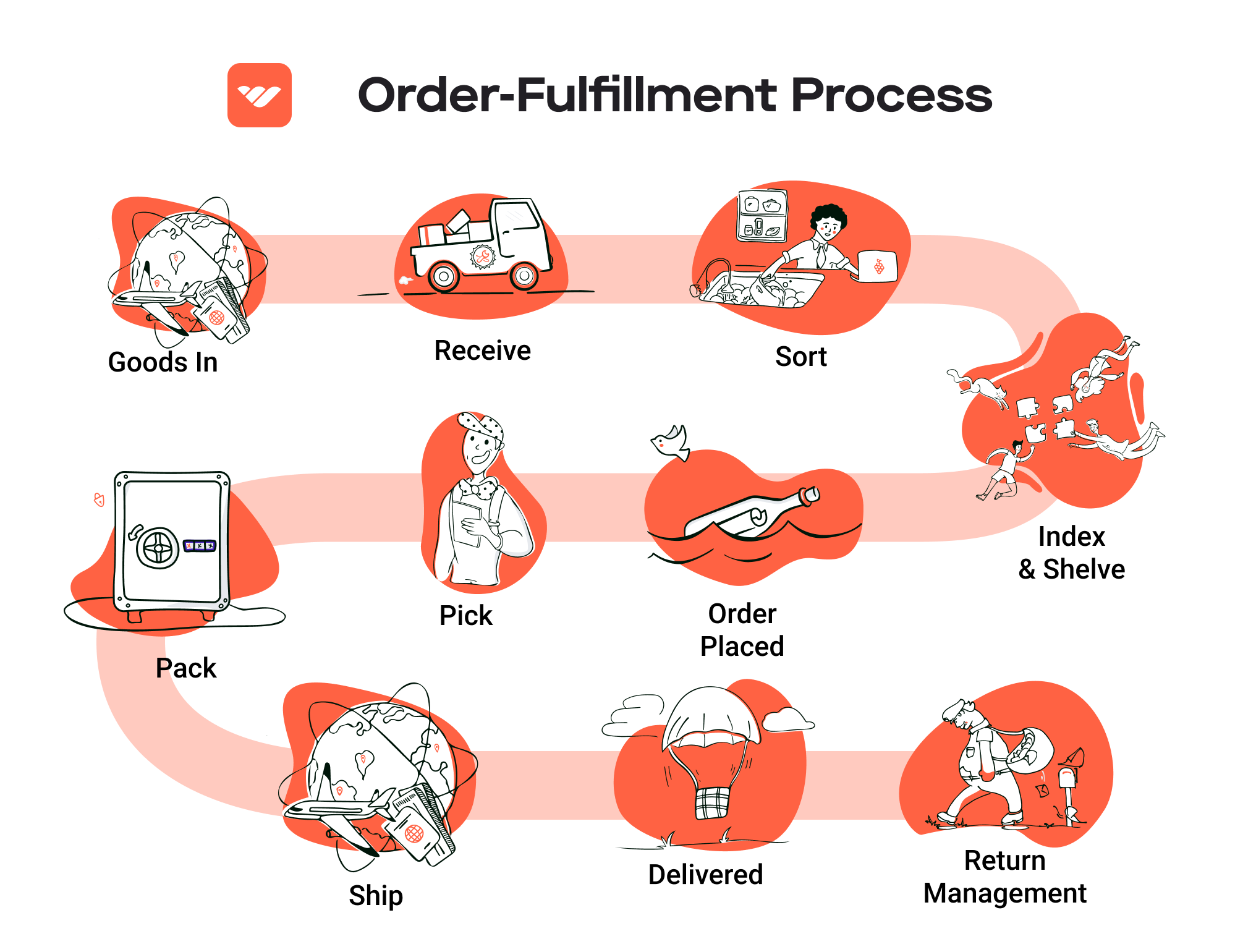
Once packed orders are labeled and loaded onto shipping vehicles, tracking becomes essential. Providing customers with tracking information enhances transparency and improves their overall experience. Utilizing shipping management software can optimize routes and manage shipping costs effectively.
Timely delivery is a significant determinant of customer satisfaction. Efficient shipping processes not only reduce costs but also contribute to a positive perception of your brand, which is vital for long-term success in e-commerce. Consistently meeting delivery expectations fosters customer loyalty and can differentiate your business in a competitive market.
By mastering each step of the order fulfillment process, businesses can scale their operations, enhance customer satisfaction, and ultimately drive growth.
Comparing Fulfillment Models: In-House vs. 3PL vs. Dropshipping
Fulfillment Model Comparison
| Model | Who Handles Inventory | Best For (Business Stage) | Key Advantage | Key Disadvantage |
|---|---|---|---|---|
| In-House Fulfillment | The business itself | Startups to established businesses | Full control over inventory and operations | High overhead costs and operational complexity |
| Third-Party Logistics (3PL) | Third-party provider | Growing businesses looking to scale | Scalability and reduced operational burden | Less control over inventory and shipping |
| Dropshipping | Supplier or manufacturer | New businesses or those testing markets | Low upfront investment and risk | Lower profit margins and potential quality issues |
In-House Fulfillment
In-house fulfillment involves managing all aspects of inventory and order processing within the business. This model is often favored by startups and established businesses that desire complete control over their operations. With in-house fulfillment, businesses can maintain direct oversight of their inventory, ensuring quality and timely shipping. This model allows for personalized customer service and the flexibility to adapt processes as necessary. However, the primary disadvantage is the high overhead costs associated with warehousing, staffing, and technology. As a business scales, the complexity of operations increases, which can strain resources and lead to inefficiencies if not managed properly. Businesses must weigh the benefits of control and quality against the costs and challenges of running a fulfillment operation.
Third-Party Logistics (3PL)
Third-party logistics (3PL) involves outsourcing the storage and shipping of products to a specialized provider. This model is ideal for growing businesses that are looking to scale quickly without the burden of managing logistics in-house. 3PL providers can offer advanced technology, logistics expertise, and a network of warehouses that can significantly enhance a company’s distribution capabilities. The key advantage of using a 3PL is the scalability it provides; businesses can expand their reach without the need for large capital investments in infrastructure. However, a notable disadvantage is the reduction in control over inventory and the shipping process. Businesses may face challenges in ensuring that their brand’s service quality is maintained when relying on an external provider. Additionally, communication issues can arise, especially if the 3PL does not fully align with the business’s goals and customer service standards.
Dropshipping
Dropshipping is a fulfillment model where the retailer does not keep goods in stock. Instead, when a customer makes a purchase, the retailer purchases the item from a third party and has it shipped directly to the customer. This model is particularly beneficial for new businesses or entrepreneurs who are testing product viability with minimal upfront investment. The primary advantage of dropshipping is the low barrier to entry; retailers can start an e-commerce business without the need for inventory or significant capital. However, dropshipping comes with its own set of challenges. Profit margins are typically lower than other models, as retailers must rely on suppliers for fulfillment, which can lead to issues with product quality and delivery times. Additionally, retailers have less control over the customer experience, which can impact brand reputation if the supplier fails to meet expectations. Overall, while dropshipping can be a low-risk way to enter the market, it requires careful supplier selection and management to ensure customer satisfaction.
Conclusion
When considering the best fulfillment model for an e-commerce business, it is essential to evaluate the unique needs and stage of the business. In-house fulfillment offers control but at a higher cost, while 3PL provides scalability and expertise but can reduce control over logistics. Dropshipping presents a low-risk entry point into e-commerce but comes with challenges related to margins and supplier reliability. Each model has its strengths and weaknesses, and the choice will ultimately depend on the business’s specific goals, resources, and market conditions.
A Deep Dive into Amazon FBA: Pros, Cons, and Who It’s For
Understanding Fulfillment by Amazon (FBA)
Fulfillment by Amazon (FBA) is a service offered by Amazon that allows sellers to store their products in Amazon’s fulfillment centers. Amazon then takes care of storage, packaging, and shipping of products directly to customers. This model enables sellers to leverage Amazon’s vast distribution network, customer service, and logistical capabilities, significantly enhancing their ability to reach customers.
When a customer orders a product, Amazon handles the entire fulfillment process, including picking the product from the warehouse, packing it, and shipping it to the customer. Additionally, Amazon manages customer service and returns for these orders, allowing sellers to focus on other aspects of their business, such as product sourcing and marketing.
How FBA Works
-
Set Up an Amazon Seller Account: To use FBA, sellers must first set up an Amazon seller account, which can be either an Individual or Professional account based on their selling needs.
-
List Products: Sellers list their products on Amazon, selecting FBA as their fulfillment method. They need to ensure that their products comply with Amazon’s guidelines and policies.
-
Ship Inventory to Amazon: After listing their products, sellers send their inventory to Amazon’s designated fulfillment centers. Amazon provides guidelines on how to package and label products correctly.
-
Amazon Handles Fulfillment: Once the inventory is in the fulfillment center, Amazon takes over. When a customer orders a product, Amazon picks, packs, and ships the item directly to the customer.
-
Customer Service and Returns: Amazon manages customer inquiries and returns for FBA orders, which can help sellers maintain a positive customer experience without dedicating resources to customer support.
Pros of FBA
1. Prime Eligibility
FBA products are eligible for Amazon Prime, which can significantly boost sales. Prime members tend to prefer products that offer fast, free shipping, which can lead to higher conversion rates.
2. Enhanced Customer Trust
By using FBA, sellers can benefit from Amazon’s reputation. Customers often trust Amazon’s fulfillment services, which can enhance the credibility of the seller and increase the likelihood of purchase.
3. Multi-Channel Fulfillment
FBA allows sellers to fulfill orders from other sales channels, such as their own websites or eBay. This capability provides flexibility and helps sellers streamline their operations by using Amazon’s logistics for all orders.
4. Scalable Operations
FBA enables sellers to scale their businesses quickly without the need for large investments in warehousing or logistics. As sales grow, sellers can send more inventory to Amazon, leveraging their infrastructure.
5. Efficient Customer Service Management
Amazon’s customer service team handles inquiries and returns for FBA products, freeing sellers from the complexities of customer service management.
Cons of FBA
1. High Fees
FBA comes with various fees, including storage fees for inventory stored in Amazon’s warehouses and fulfillment fees for each item sold. These costs can add up and eat into profit margins, particularly for sellers with lower-priced items.
2. Strict Inventory Rules
Amazon has strict policies regarding inventory management, including guidelines for labeling and packaging. Sellers must adhere to these rules to avoid additional charges or penalties.
3. Commingling Risks
When using FBA, sellers’ products may be commingled with those of other sellers. This can lead to issues if a customer receives a damaged or defective product that was not from the seller’s inventory. Additionally, it complicates tracking performance and quality control.
4. Loss of Control Over Shipping
While Amazon’s logistics capabilities are a significant advantage, sellers lose some control over the shipping process. Issues such as delays or mistakes in fulfillment are handled by Amazon, which can impact the seller’s reputation.
5. Dependency on Amazon
Using FBA ties a seller’s success closely to Amazon’s platform. Changes in Amazon’s policies, fees, or algorithms can significantly impact a seller’s business without warning.
Who is FBA Best For?
FBA is particularly well-suited for:
- Small to Medium-Sized Businesses: Those looking to scale without the overhead of managing warehousing and logistics.
- Sellers with High Sales Volume: Businesses that anticipate high sales volumes can benefit from the efficiencies of FBA, particularly when it comes to shipping and customer service.
- New Sellers: Entrepreneurs entering the e-commerce space can leverage Amazon’s infrastructure and customer base to gain traction quickly.
- Sellers with Diverse Product Lines: Those offering a variety of products can take advantage of Amazon’s fulfillment capabilities to streamline operations across multiple listings.
- Brands Looking to Increase Visibility: Sellers aiming to enhance their brand visibility through Amazon Prime and other promotional opportunities will find FBA beneficial.
In conclusion, while FBA offers numerous advantages that can help businesses scale and streamline operations, it also comes with challenges that sellers must navigate. Understanding both the pros and cons is essential for making informed decisions about whether to utilize Amazon’s fulfillment services in your e-commerce strategy.
Core Services Offered by Fulfillment Centers
Inventory Management & Warehousing
Inventory management is a critical component of e-commerce fulfillment. Fulfillment centers offer sophisticated inventory management systems that track stock levels, manage reorders, and provide real-time visibility into inventory status. This service typically includes:
- Real-Time Tracking: Fulfillment centers utilize advanced software solutions to monitor inventory in real time, allowing businesses to make informed decisions about stock levels and reorder points.
- Stock Optimization: By analyzing sales data, fulfillment centers can help businesses understand demand patterns, enabling them to optimize their inventory levels and reduce holding costs.
The benefits of effective inventory management and warehousing are significant. By maintaining optimal stock levels, e-commerce businesses can minimize the risk of stockouts and overstock situations. This not only enhances customer satisfaction through timely order fulfillment but also improves cash flow by reducing excess inventory costs. Additionally, with centralized warehousing, businesses can streamline their logistics processes, resulting in faster shipping times and reduced operational costs.
Pick and Pack Services
Pick and pack services are essential for e-commerce businesses looking to efficiently fulfill customer orders. This process involves selecting items from inventory (picking) and preparing them for shipment (packing). Fulfillment centers typically offer:
- Automated Picking Systems: Many fulfillment centers employ automated systems that streamline the picking process, reducing the time it takes to gather items for orders.
- Quality Control Checks: Before packing, fulfillment centers often conduct quality control checks to ensure that the correct items are selected and in good condition.
The primary benefit of pick and pack services is the speed and accuracy they bring to order fulfillment. Automated systems reduce human error, ensuring that customers receive the correct products. Faster picking and packing processes lead to quicker shipping times, which can significantly enhance customer satisfaction and loyalty. Additionally, outsourcing these services allows e-commerce businesses to focus on core operations, such as marketing and product development, while leaving the logistics to experts.
Kitting and Assembly
Kitting and assembly services allow e-commerce businesses to offer bundled products or customized kits. This process involves assembling multiple products into a single package or kit, which can be particularly beneficial for promotional items or gift sets. Fulfillment centers provide:
- Custom Kitting Solutions: Fulfillment centers can create unique product bundles tailored to specific marketing campaigns or customer preferences.
- Efficient Assembly: Skilled labor at fulfillment centers can quickly assemble products, ensuring that kits are ready for shipment in a timely manner.
The benefits of kitting and assembly are manifold. By offering bundled products, businesses can increase average order value and provide customers with a more convenient shopping experience. Additionally, kitting can streamline inventory management by reducing the number of individual SKUs that need to be tracked. This service can also enhance brand perception by offering thoughtfully curated products that meet customer needs.
Returns Management (Reverse Logistics)
Returns management, or reverse logistics, is a crucial service provided by fulfillment centers, especially in the e-commerce sector where return rates can be high. This service encompasses the entire process of handling returned products, including:
- Efficient Processing: Fulfillment centers manage the logistics of returns, ensuring that returned items are quickly processed and restocked or disposed of as necessary.
- Customer Communication: Many fulfillment centers provide support for customer inquiries related to returns, improving the overall customer experience.
The benefits of effective returns management are significant. By streamlining the return process, e-commerce businesses can enhance customer satisfaction and loyalty. Efficient returns management can also minimize losses associated with returned goods by quickly restocking items that are still sellable. Moreover, a well-handled return process can improve a brand’s reputation, as customers are more likely to shop with businesses that offer hassle-free returns.
Conclusion
In summary, fulfillment centers offer a variety of core services that are essential for e-commerce businesses looking to scale their operations. From inventory management and warehousing to pick and pack services, kitting and assembly, and returns management, these services not only enhance operational efficiency but also improve customer satisfaction. By leveraging these fulfillment center services, e-commerce businesses can focus on growth and innovation, leaving the complexities of logistics to experienced professionals.
How to Choose a Fulfillment Partner: A 6-Point Checklist
Location & Warehouse Network
Importance:
The geographical location of your fulfillment partner’s warehouses can significantly impact shipping times and costs. A partner with strategically located warehouses can help you reach your customers faster, which is essential in today’s e-commerce landscape where consumers expect quick delivery.
Questions to Ask:
– Where are your warehouses located, and how does that affect shipping times to my primary customer base?
– Do you have multiple warehouses that allow for distribution across different regions?
– What are your shipping partnerships and carrier options to optimize delivery speeds and costs?
Technology & Integrations
Importance:
A robust technological framework is essential for seamless order processing, inventory management, and real-time tracking. Your fulfillment partner’s technology should easily integrate with your existing systems (e.g., e-commerce platforms, ERP systems) to streamline operations.
Questions to Ask:
– What technology platforms do you use for order management and inventory tracking?
– Can your system integrate with my current e-commerce platform (e.g., Shopify, WooCommerce, Magento)?
– Do you offer real-time inventory updates, and how can I access this information?
Specializations (e.g., Cold Storage, Oversized Items)
Importance:
Different products require different handling and storage conditions. If your business involves specialized products (like perishables or oversized items), it’s crucial to ensure that your fulfillment partner has the necessary capabilities and expertise.
Questions to Ask:
– Do you have specialized storage solutions for my product type (e.g., temperature-controlled storage for food items)?
– What handling procedures do you have in place for fragile or oversized items?
– Can you accommodate seasonal fluctuations in inventory levels for specialized products?
Scalability & Capacity
Importance:
As your business grows, your fulfillment partner should be able to scale operations accordingly without compromising service quality. Understanding their capacity and scalability options is critical to ensure they can handle increased demand during peak seasons or business expansions.
Questions to Ask:
– What is your current capacity, and how quickly can you scale operations if my order volume increases?
– Do you have contingency plans in place for sudden spikes in demand, such as during holiday seasons?
– How do you handle overflow inventory during peak times?
Pricing and Contracts
Importance:
Transparent pricing and flexible contract terms are vital for maintaining healthy cash flow and ensuring that your fulfillment costs align with your business model. Understanding the cost structure will help you avoid unexpected expenses.
Questions to Ask:
– Can you provide a detailed breakdown of your pricing structure (e.g., storage fees, pick and pack fees, shipping costs)?
– Are there any hidden fees I should be aware of (e.g., for returns, special handling)?
– What are your contract terms, and do you offer flexibility for scaling up or down?
Customer Support & Reviews
Importance:
Reliable customer support is essential for resolving issues quickly and maintaining smooth operations. Additionally, researching reviews can provide insights into the partner’s reputation and the quality of service they provide.
Questions to Ask:
– What customer support channels do you offer (e.g., phone, email, chat)?
– How quickly can I expect a response to inquiries or issues?
– Can you provide references or reviews from other clients in my industry?
Conclusion
Choosing the right fulfillment partner is a crucial decision that can significantly affect your e-commerce business’s efficiency and customer satisfaction. By thoroughly evaluating potential partners against the checklist above, you can make an informed decision that aligns with your business goals and customer expectations. Always remember to conduct due diligence, seek testimonials, and, if possible, visit the facilities to ensure that the partner can meet your operational needs effectively.
Understanding Fulfillment Pricing: A Breakdown of Common Fees
Initial Setup Fees
When partnering with a fulfillment center, the initial setup fees are often the first costs you encounter. These fees can vary significantly depending on the complexity of your operations and the services required. Typically, setup fees cover the costs of onboarding, which may include configuring your account, integrating your e-commerce platform, and establishing the necessary software connections for inventory management.
Initial setup fees can range from a few hundred to several thousand dollars. Factors influencing this cost include the number of products you sell, the need for custom packaging, and any specific software integration required. To mitigate these fees, it’s advisable to ask for a detailed breakdown of what is included in the setup process and to negotiate based on your unique business needs.
Receiving Fees
Receiving fees are charged when your inventory arrives at the fulfillment center. These fees typically cover the labor costs associated with unloading, inspecting, and storing your products. The calculation of receiving fees is generally based on the volume of goods received, measured in either units or pallets.
For example, a fulfillment center may charge a flat fee per pallet or a per-unit fee that can range from $5 to $25, depending on the size and weight of the items. To optimize costs, you might consider consolidating shipments to reduce the frequency of deliveries, thereby minimizing the number of receiving fees incurred.
Storage Fees (per pallet/bin)
Storage fees are incurred for the duration your inventory is held in the fulfillment center. These fees are typically charged on a monthly basis and can be calculated per pallet, bin, or cubic foot. The storage fee structure may vary based on the seasonality of your business; for instance, higher fees might be charged during peak seasons when space is at a premium.
Storage fees can range from $10 to $40 per pallet per month, depending on the location and the fulfillment center’s pricing model. To minimize storage costs, consider regularly reviewing your inventory turnover rates and implementing strategies for just-in-time inventory management, ensuring that you’re not holding excess stock.
Pick & Pack Fees (per item/order)
Pick and pack fees cover the labor involved in retrieving items from storage and preparing them for shipment. This fee is typically calculated on a per-item or per-order basis. For example, a fulfillment center might charge $1 to $3 per item picked and packed, with discounts available for larger orders.
It’s important to note that these fees can increase if your orders require special packaging or additional services such as kitting or custom labeling. To optimize pick and pack costs, streamline your product offerings and consider offering fewer variations of products to reduce complexity in the picking process.
Shipping Fees
Shipping fees represent one of the most significant costs in the fulfillment process. These fees can vary widely based on factors such as the shipping carrier, the destination, package weight, and dimensions. Fulfillment centers may offer different shipping options, including standard, expedited, and international shipping, each carrying its own cost structure.
Shipping fees are typically calculated based on the distance to the delivery address and the weight of the package. Many fulfillment centers also offer discounts through partnerships with major carriers, which can significantly reduce costs. To manage shipping expenses effectively, consider using a multi-carrier shipping strategy that allows you to select the most cost-effective options based on order size and destination.
Tips for Getting an Accurate Quote
To obtain an accurate quote for fulfillment services, consider the following tips:
-
Provide Detailed Information: When requesting quotes, be specific about your product types, volumes, and any special handling requirements. This will help fulfillment centers provide a more tailored quote.
-
Ask for Transparency: Request a detailed breakdown of all fees associated with the fulfillment process, including hidden costs that may arise during peak seasons.
-
Negotiate Terms: Don’t hesitate to negotiate fees, especially if you expect to have a long-term partnership or significant order volume.
-
Compare Multiple Providers: Gather quotes from several fulfillment centers to compare pricing and services. This will give you a better understanding of the market rates and help you identify the best fit for your business.
-
Consider Future Growth: Choose a fulfillment partner that can scale with your business. Ask about pricing structures for increased volumes to avoid unexpected costs as your business grows.
By understanding these common fulfillment pricing models and taking proactive steps to manage costs, you can optimize your logistics operations and enhance your e-commerce business’s profitability.
Frequently Asked Questions (FAQs) about Fulfillment
Understanding Fulfillment in E-commerce
-
What is fulfillment in e-commerce?
Fulfillment in e-commerce refers to the complete process of receiving, processing, and delivering orders to customers. This includes inventory management, order picking and packing, shipping, and handling returns. A well-optimized fulfillment strategy can enhance customer satisfaction and increase operational efficiency. -
What is the difference between a warehouse and a fulfillment center?
A warehouse primarily serves as a storage facility where goods are kept until they are needed. In contrast, a fulfillment center is specifically designed to manage the entire order fulfillment process, including order processing, packing, and shipping. Fulfillment centers often utilize technology to streamline operations and improve delivery speed. -
What is a 3PL (Third-Party Logistics)?
A 3PL is a service provider that manages logistics and fulfillment services for businesses. This can include warehousing, inventory management, order processing, and shipping. Partnering with a 3PL allows businesses to focus on their core competencies while outsourcing the complexities of logistics. -
How much do fulfillment services cost?
The cost of fulfillment services varies based on factors such as order volume, storage needs, and the complexity of operations. Typically, businesses can expect to pay for storage space, picking and packing fees, shipping costs, and any additional services like returns processing. It’s essential to compare different providers and their pricing structures to find the best fit for your business. -
What factors should I consider when choosing a fulfillment partner?
When selecting a fulfillment partner, consider their location, technology and automation capabilities, shipping options, scalability, and customer service. It’s also crucial to assess their experience with your specific industry and product types, as well as their reputation in the market. -
How can I improve my fulfillment process?
To enhance your fulfillment process, consider implementing inventory management software, automating order processing, optimizing your warehouse layout, and establishing clear communication channels with your fulfillment partner. Regularly reviewing your fulfillment metrics can also help identify areas for improvement. -
What role does technology play in fulfillment?
Technology plays a critical role in modern fulfillment operations. Tools like inventory management systems, order management software, and automated picking systems can significantly increase efficiency, reduce errors, and provide real-time visibility into inventory levels and order statuses. -
How do I handle returns in my fulfillment process?
Establishing a clear returns policy and process is essential for effective returns management. This includes creating return labels, providing customers with easy return instructions, and integrating returns into your inventory management system. A streamlined returns process can enhance customer satisfaction and loyalty. -
What are the benefits of using a fulfillment center?
Using a fulfillment center can offer several benefits, including reduced operational costs, improved shipping times, access to advanced technology, and scalability to handle fluctuations in order volume. It allows businesses to focus on growth while ensuring that logistics are managed efficiently. -
How can I scale my fulfillment operations?
To scale your fulfillment operations, consider evaluating your current processes for bottlenecks, investing in automation, and expanding your warehousing capabilities. Partnering with a reliable 3PL can also provide the flexibility and expertise needed to manage increased demand effectively. Regularly analyzing fulfillment metrics will help inform your scaling strategy.
By understanding these key aspects of fulfillment, e-commerce business owners can make informed decisions that drive efficiency and enhance customer satisfaction.
Conclusion: Is Outsourcing Fulfillment the Right Move for Your Business?
The Case for Outsourcing Fulfillment
Outsourcing your fulfillment operations can be a game-changer for your e-commerce business. By leveraging a fulfillment service, you can save valuable time and resources that would otherwise be spent managing logistics. This allows you to focus on what truly matters: growing your brand, enhancing your product offerings, and improving customer satisfaction.
One of the most significant advantages of utilizing a fulfillment partner is scalability. As your business grows, so do your shipping and inventory management needs. A professional fulfillment service is equipped to handle fluctuations in order volume, ensuring that you can scale your operations seamlessly without the headaches of managing additional warehouse space or staffing. This flexibility is essential in today’s fast-paced e-commerce landscape, where consumer demands can change overnight.
Moreover, partnering with a fulfillment expert brings a wealth of knowledge and experience to your operations. These professionals understand the nuances of shipping logistics, customs regulations, and inventory management. By outsourcing to a dedicated service, you gain access to best practices and technologies that can enhance your operational efficiency and reduce shipping errors, ultimately leading to happier customers.
However, it’s crucial to choose the right fulfillment partner. Not all services are created equal, and the wrong choice can hinder your growth rather than support it. Take the time to research potential partners, ensuring they align with your business goals and can offer the level of service your customers expect.
As a strategic next step, consider auditing your current shipping processes. Evaluate whether your operations are sustainable and scalable for future growth. If you find gaps or inefficiencies, it may be time to explore fulfillment options that can propel your business forward. The right partner could be the key to unlocking your e-commerce potential.
Important Disclaimer
⚠️ Important Disclaimer
The information in this guide is for educational purposes. Fulfillment services, pricing, and platform features change frequently. Always conduct your own due diligence and consult with providers directly before making business decisions.
